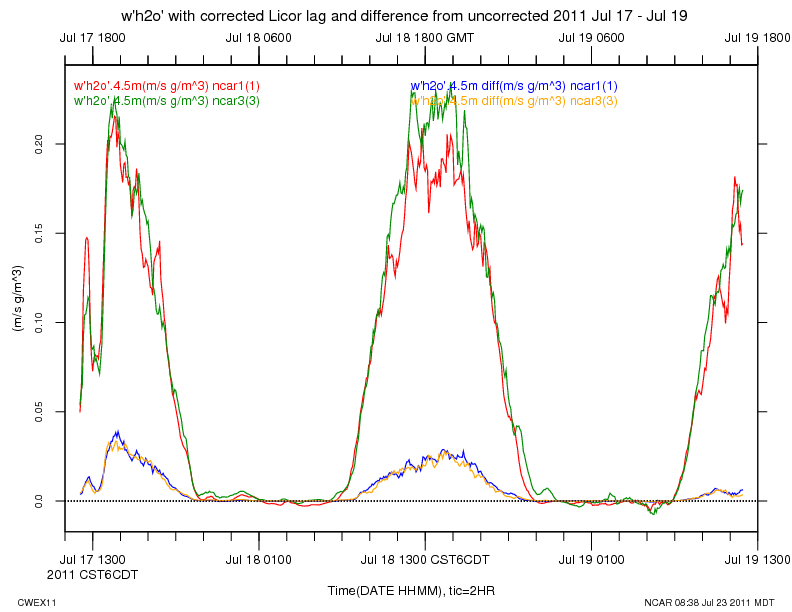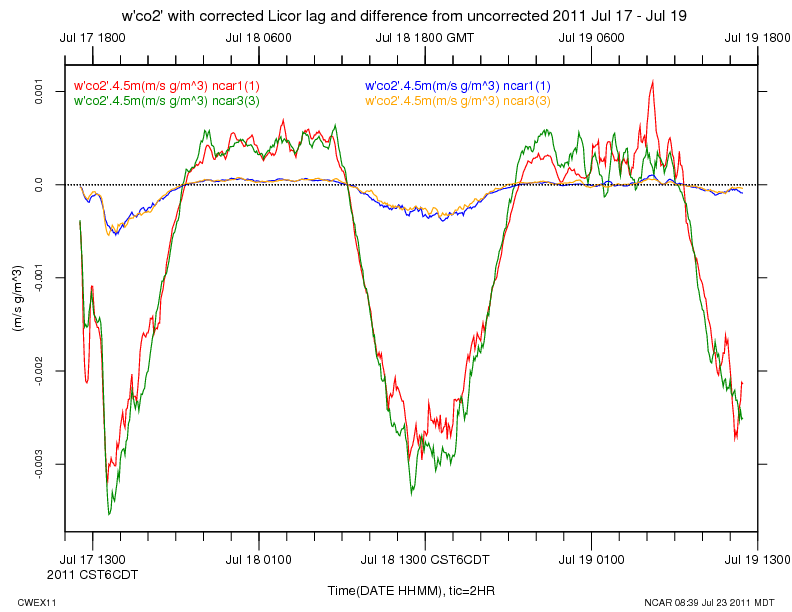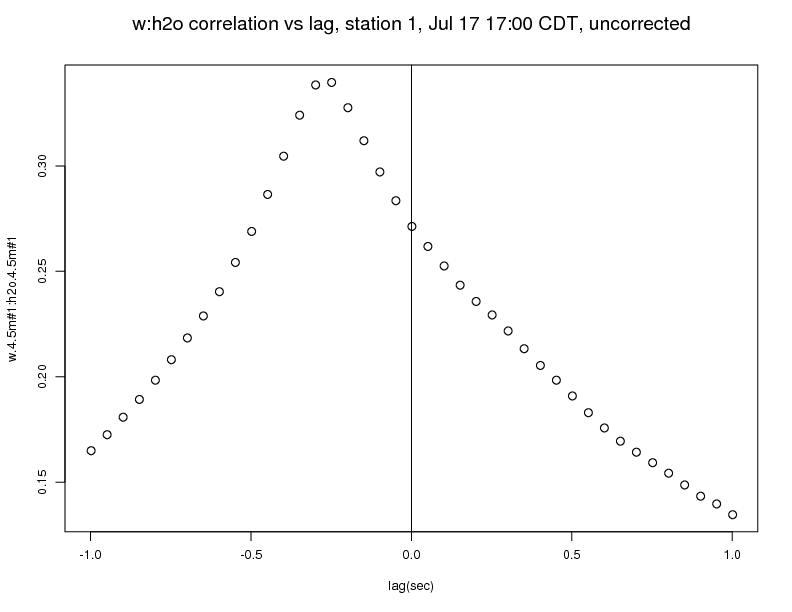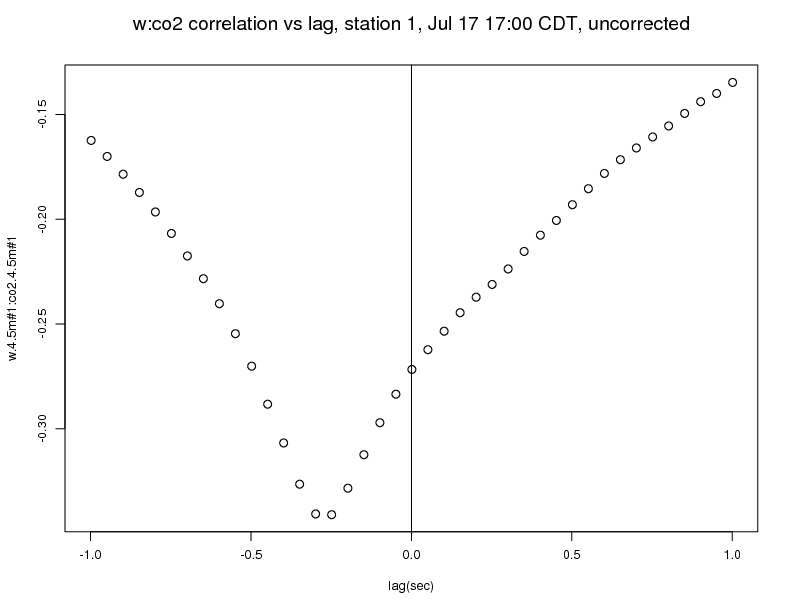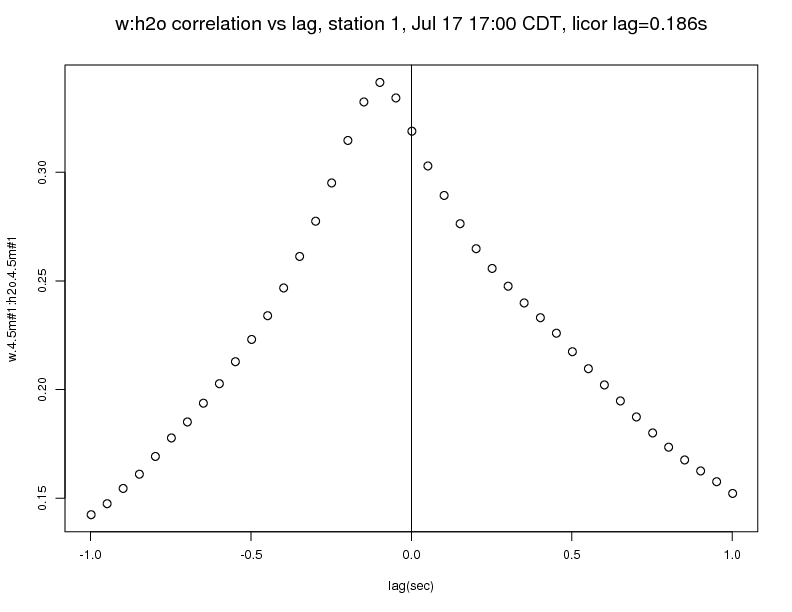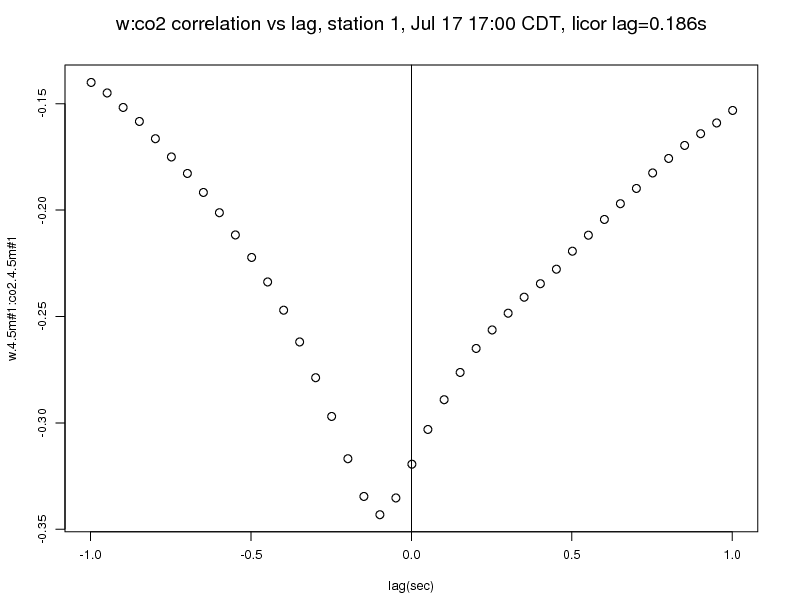7/26/11
From plots of vertical velocity (mostly), wind direction, and pressure, I deduced the following times at which the masts were lowered and raised. I entered these times into the sonic qc files (in order to delete data while the mast was down), adding 5 minutes to the raising time to allow for attaching and adjusting the back guy wire.
Date |
Stn |
lowered |
raised |
|---|---|---|---|
July 5 |
4 |
15:20 |
16:45 |
July 8 |
2 |
14:07 |
?14:14 |
|
4 |
15:08 |
15:14 |
July 15 |
2 |
11:11 |
11:20 |
|
4 |
13:23 |
13:33 |
July 22 |
2 |
10:28 |
10:44 |
|
4 |
12:15 |
12:25 |
July 25 |
1 |
09:51 |
10:55 |
|
2 |
11:35 |
12:08 |
|
4 |
13:11 |
13:33 |
Aug 2 |
2 |
10:17 |
10:29 |
|
4 |
11:22 |
11:31 |
July 24-25, [July 26 9:05 CDT]
Dan Rajewski (in Ames)
Summary: Stations 1-4 operational, Steve O. , Russ, and Dan serviced the towers morning and afternoon of July 25
slightly cooler air on July 24, north of very warm air, light wind speed, northerly on July 24, variable directions on July 25
**replaced the fan for the 2m temp/RH at stn 2, cleaned the fan for the 2m temp/RH at stn 1, replaced the fan for the 10 m temp/RH at stn 1
(see Steve O. blog entries on the station visits)
Vdsm: 13.5-13.8 V during day, down to 12.5 at night
P: ok, pressure mostly steady on July 24, dropping 5mb the morning/afternoon of July 25
T.2m: stn 2 reading 0.5-1.0 degrees C warmer than other before the fan repair on July 25
RH.2m: stn 4 highest during day and night; before fan repair: stn 2 lowest during late morning and afternoon, stns 1-3 few%RH within each other
H2O.2m: stn 4 high during day and night (0.7-1.0 g/m^3 moister than other sites), stn 1 slightly lower than stns 2 & 3 both day and night
Wetness: slight shower at 6:00 and 11:00 on July 24, dew accumulation from 0:30-6:30 [July 25] sensor dry by 8:30
T.10m: before fan repair: stn1 slightly warmer than others during the daytime, at stn 1 fan quit (blown fuse) around 5:00 [July 25], after repair fields are ok
RH.10m: before fan repair: stn 1 few%RH drier than other sites for afternoon of July 24, sites close in agreement after the repair
H2O.10m: ok, night: stn 2 about 0.5 g/m^3 moister than stn 4, stn 1 & 3 close together, day: stns about 0.3 g/m^3 of each other; not much change after fan repair
Spd.10m: ok, post midnight hours of July 25, stn 2 lower than other sites by 0.5 m/s, stn 4 also a bit lower than other stns during late morning-mid afternoon
Dir.10m: ok, winds from all directions on July 24, mostly Easterly the after midnight on July 25, Southerly by late morning
T.10m - T.2m: before fan repair: stn 2 most negative during day; stn 1 somewhat more positive at 10m vs. 2 m.; after fan repairs little difference in vertical gradient among all sites
H2O.10m - H2O.2m: before and after repair: stn 4 most negative during night/day; see H20.2m, other stations in close agreement for night and day
spd.4.5m: ok, see comments for Spd.10m, less variability among sites for afternoon of July 25
dir.4.5m: ok, see comments for Dir.10m
w.4.5m: ok, stn 4 slight w>0 for afternoon/evening of July 24 (northerly winds?)
tc.4.5m: ok, night: stn 2 is about 0.5 degrees C cooler than other sites; day: all sites agree within +/- 0.5 degrees C
ldiag: ok
kh2oV: stn2 2 & 4 about 50-150 mV for day/night behavior before the kryptons were replaced; after switching sensors about 220 to 150 mV
kh2o: before sensor krypton replacement: stns 2 & 4 about 2-3 g/m^3 lower than stns 1 & 3; after sensor swap water content within 0.5-0.7 g/m^3 of stns 1 & 3
h2o(licor): ok
lidiag (licor): spike during late morning rain shower on July 24, high moisture spike also at stn 3 before midnight
TKE.4.5m: ok, stn 2 has slightly more TKE than other sites around midnight of July 24, but less TKE than other stns from 2:00-5:00 on July 25
w'w': ok, similar to TKE.4.5m, also in u'u' and v'v'
u*: ok, similar to TKE.4.5m, also in v'w' and u'w' for July 25 event
w'tc': ok, stn 3 slightly higher daytime heat flux than other sites for July 25
tc'tc': ok
w'h2o': ok, stn 2 significantly low during day before replacement, after repair: better agreement for stn 2 & 4 with the other sites, stn 3 slightly higher daytime flux than other sites on July 25
h2o'h2o' (licor): ok
kh2o'kh2o': before replacement: stn 4 close to stns 1 & 3 daytime value, stn 2 a bit lower, after sensor swap stn 2 closer to stn 4, both about 0.2 units less variable than sites 1 & 3
w'co2': ok, close day and night agreement, slightly more flux <0 at stn 1 for early afternoon of July 24
co2'co2': ok
1307: Purpose: change out krypton
1313: Mast lowered
Replaced 1390(?) by 1394. Voltage almost 0.3V.
1337: Mast raised
P.S. Gordon updated the cal_file for this site.
Just a quicky for me to look at station, since no known problems.
1245: briefly turned off power on 2m TRH to be able to hear 10m TRH. Then turned its power off as well. All okay, turned back on.
1300: left site
1130: Lower mast
Replace krypton (1393?) with 1525 (that had been set to 1cm pathlength by CG/SRS last week). Now read about 0.25V.
2m TRH fan totally stuck by bug body glue. Was able to scrape out and get fan running again, but brought back to lab for better cleaning (left on Dan's desk). Instead, used the second fan I brought with me for this unit. Note that this fan has a bit of bearing noise and may need to be replaced itself before the end of the project. (Hence, put at 2m.)
10m TRH fan had just a fine coating of what looked like soil dust. Wiped a bit of this off, but otherwise left unchanged. Note that the bug problem is with the sensor closer to the ground/canopy, which makes sense.
1218: Raise mast
Power check: (again requiring DSM power cycling twice)
13.8V @ 0.94-0.98A (varies)
1230: left site
P.S. Gordon updated the cal_file for this site later in the afternoon.
Purpose: Thought we were just visiting!
People: (for this and next 3 visits): Dan, Russ, SteveO
On site at 0845, discovered that 10m TRH wasn't working at all.
0928: Power test: (requires shutdown of DSM; restart with blue box; shutdown again)
13.6V @ 1.4A (varies a bit) -- note only 1 TRH
13.6V @ 1.36A (with only one TRH, add this back in for a total station consumption of 1.44A)
[I note that on my lab bench a fan took about 12V@0.03A.]
0950: lower mast
Had several TRH problems: 10m completely dead, 2m fan dirty. At one point, swapped TRHs to find that both wouldn't work. Ended up deciding to put "best" TRH (formerly at 2m) with "best" fan (the better of the 2 fans I brought out with me) at 10m. Had to replace fuse on Diamond interface panel (tested that it was dead). Used interface panel channel 11 (not being used) for "spare" fuse.
The old 10m had a destroyed fan (brass shavings everywhere; blade disconnected from shaft). I'm bringing this back to Boulder, though probably should be thrown out. The SHT module worked in the 2m housing, so left unchanged. However, with "new" fan (stolen from old 2m TRH), it still would not work. I opened up the Bulgin connector side but saw no obvious problems with the 232 converter board. Reassembled and then this sensor worked -- very mysterious. Decided it was good to leave this at 2m to make servicing easier in case it fails again. Would be a good idea to have a spare TRH housing here.
1100: mast up (all that TRH stuff took a while to diagnose/fix)
Initially, Licor didn't work due to me removing its ribbon connector on the interface panel to access the port 7 fuse. Reconnected about 1105.
Jul 24, 8 am MDT.
Using the documented Licor 7500 sensor lag of 0.186 seconds, the 5 minute statistics were recomputed last night for the entire project, and the webplots regenerated. Per Tom's suggestion, 1/2 hour smoothing is now being applied to the plots of turbulence variables.
July 23, 14:30 CDT
Dan Rajewski (in Ames)
Summary: Stations 1-4 operational, no ISFS staff on site
partly to mostly cloudy skies with late evening showers and early afternoon showers; within storm track north of stationary front (very warm and humid air to south)
**2m Temp stn 2 remains warmer in daytime, stn 4 cooler at nighttime
Vdsm: 13.5-13.8 V during day, down to 12.5 at night
P: ok, stn 1 & 2 pressure slightly higher than at sites 3 & 4, rising from 970 to 973 mb
T.2m: stn 2 warmer than others during the day (fan??), about comparable to other sites during the night (0.5 degree warmer at stns 1 -3 vs. 4)
RH.2m: stn 4 high during day; stn 2 lowest during late morning and afternoon, stns 1-3 few%RH within each other
H2O.2m: stn 4 high during day and night (0.7-1.0 g/m^3 moister than other sites), stn 1 slightly lower than stns 2 & 3 both day and night
Wetness: slight wet from shower at 20:30, dry by 21:30, wet again with shower at 10:00 and again early afternoon
T.10m: stn1 slightly warmer than others during the late morning before rain showers; night all stns within 0.5 degree C of each other
RH.10m: ok, mostly in agreement , night; stns 1 & 3 close together, stns 2 & 4 about few%RH drier; daytime stn 1 5%RH lower than stn 2 & 3, few%RH lower than stn 4
H2O.10m: ok, night: stn 2 about 0.5 g/m^3 moister than stn 4, stn 1 & 3 close together, day: stns about 0.3 g/m^3 of each other
Spd.10m: ok, no long period of one site a few 0.5 m/s different than the other sites
Dir.10m: ok, Easterly wind before sunrise, SE to SSE by 13:00 before contamination from afternoon thunderstorms
T.10m - T.2m: stn 2 most negative during day; see T.2m, stn 3 & 4 less negative than stn 4, stn 1 least negative during day; close agreement at night
H2O.10m - H2O.2m: stn 4 most negative during night/day; see H20.2m, other stations in close agreement for night and day
spd.4.5m: ok, see comments for Spd.10m
dir.4.5m: ok, see comments for Dir.10m
w.4.5m: ok, all sites have larger w<0 as night and morning progresses, stns 1 & 2 least negative in daytime, 3 & 4 more negative
tc.4.5m: ok, night: stn 2 is about 0.5 degrees C cooler than other sites; day: all sites agree within +/- 0.5 degrees C
ldiag: stn 4 has anomalous readings much of overnight 19:30-3:30
kh2oV: anomalous increase at stn 2 & 4 night, daytime about 60 mV
kh2o: stns 2 & 4 about 2-3 g/m^3 lower than stns 1 & 3 during night, poor readings during rain showers
h2o(licor): ok, stn 1 & 3 in very good agreement except during rainfall
lidiag (licor): overnight spike at stn 3 also during morning/ early afternoon showers
TKE.4.5m: ok, mostly in agreement (clouds and rain with some wind keep turbulence uniform night/day?)
w'w': ok, similar to TKE.4.5m and v'v'; slightly more u'u' at stn 1 & 3 from 3:00-5:00,
u*: ok, similar to TKE.4.5m, also in v'w'; u'w' similar to v'v'
w'tc': ok
tc'tc': ok
w'h2o': ok, stn 2 significantly low during day, stn 1-4 about the same night: all sites flux low and > 0
h2o'h2o' (licor): ok, spikes during rain fall events
kh2o'kh2o': stn 4 close to stns 1 & 3 daytime value, stn 2 a bit lower, spikes also during rainy periods
w'co2': ok, close day and night agreement, slightly more flux <0 at stn 3 during mid morning-early afternoon before rain
co2'co2': ok, expected spikes during periods of rainfall
According to the Licor 7500 manual, there is a 0.186 second sampling lag in the 7500. This can be increased with an output delay parameter, so that it can be synchronized with the sampling of a sonic. I've verified that the output delays on our 7500's are set to 0.
Since the CSAT3 and Licor operate asynchronously, I see no advantage in further adjustment of the Licor delay to be a multiple of the CSAT3 sample period.
We have not been incorporating a 7500 lag in our data processing. We do correct for the 2 sample delay of the CSAT3 sonics. Subtracting 0.186 seconds from the 7500 samples does increase the correlation and fluxes between w and h2o and co2. The w'h2o' and w'co2' fluxes increase by about 15% when a lag of 0.186 is applied to the Licor data. These plots are of the corrected flux and the difference between the corrected and uncorrected fluxes, for 2 days, centered on Jul 18:
Here are the correlation vs lag plots between w and h2o and co2 from station 1 for Jul 17, 17:00 - 17:30 CDT. The wind was out of the south at this time:
After applying a 0.186 second lag to the Licor data, you can see that the correction is in the right direction, but there is still a lag of about 2 samples, 0.1 seconds:
(It pays to read the manual!)
For future reference, here is the splus code to plot the correlations:
dpar(start="2011 jul 17 17:00",lenmin=30,stns=1)
iod = prep(c("w.4.5m#1","h2o.4.5m#1","co2.4.5m#1"),rate=20)
x = readts(iod)
close(iod)
cwh = crosscorr(x[,1:2],lags=c(-1,1))
plot(as.numeric(utime(positions(cwh))),cwh,xlab="lag(sec)",ylab="w.4.5m#1:co2.4.5m#1")
Jul 22, 19:10 CDT (00:10 UTC)
Checked that the additional Licor 7500 delay values are set to 0. See https://wiki.ucar.edu/x/9KWTB about how to talk to Licor 7500's.
ncar1:
(Outputs ?) (Outputs (BW 20)(Delay 0)(SDM (Address 7))(Dac1 (Source CO2MMOL)(Zero 0)(Full 2.5000000e1 ))(Dac2 (Source H2OMMOL)(Zero 0)(Full 5e2))(RS232 (Baud 19200)(Freq 2e1)(Pres TRUE)(Temp TRUE)(Aux FALSE)(Cooler FALSE)(CO2Raw TRUE)(CO2D TRUE)(H2ORaw TRUE)(H2OD TRUE)(Ndx FALSE) (DiagVal TRUE)(DiagRec FALSE)(Labels FALSE)(EOL "0A")))
ncar3:
(Outputs ?) (Outputs (BW 20)(Delay 0)(SDM (Address 7))(Dac1 (Source NONE)(Zero 0)(Full 5))(Dac2 (Source NONE)(Zero 0)(Full 5))(RS232 (Baud 19200)(Freq 2e1)(Pres TRUE)(Temp TRUE)(Aux FALSE)(Cooler FALSE)(CO2Raw TRUE)(CO2D TRUE)(H2ORaw TRUE)(H2OD TRUE)(Ndx FALSE)(DiagVal TRUE)(DiagRec FALSE)(Labels FALSE)(EOL " 0A")))
Later, at 19:45 CDT (00:47 UTC) set the Dac1 and Dac2 (digital to analog converters, which we don't sample) on ncar1 to Source NONE. I don't expect that it will have any real effect - except maybe save a little power.
(Outputs (Dac1 (Source NONE)(Zero 0)(Full 5)) (Dac2 (Source NONE)(Zero 0)(Full 5)))
Some documentation for the Licor 7500 diagnostic value is in the manual:
ftp://ftp.licor.com/perm/env/LI-7500/Manual/LI-7500Manual_V4.pdf
The following excerpts are from the manual.
Setup and Operation, page 3-36:
The cell diagnostic value is a 1 byte unsigned integer (value between 0 and 255) with the following bit map:
bit 7 Chopper 1=ok
bit 6 Detector 1=ok
bit 5 PLL 1=ok
bit 4 Sync 1=ok
bit 3-0: AGC/6.25Example: a value is 125 (01111101) indicates Chopper not ok, and AGC = 81% (1101 is 13, times 6.25)
If bits 4-7 are 1 (OK), the value will be greater than or equal to 240, with the remainder being the AGC percentage. I've not seen values below 248. Note that the values on the plots and in the netcdf files are 5 minute averages.
We're seeing values of 248 and above, indicating the following:
lidiag |
Chopper |
Detector |
PLL |
Sync |
AGC % |
|---|---|---|---|---|---|
248 |
ok |
ok |
ok |
ok |
50-56 |
249 |
ok |
ok |
ok |
ok |
56-63 |
250 |
ok |
ok |
ok |
ok |
63-69 |
251 |
ok |
ok |
ok |
ok |
69-75 |
252 |
ok |
ok |
ok |
ok |
75-81 |
253 |
ok |
ok |
ok |
ok |
81-87 |
254 |
ok |
ok |
ok |
ok |
88-94 |
255 |
ok |
ok |
ok |
ok |
94-100 |
The manual doesn't define AGC, but contains this info, on pages 3-50,51, indicating that an AGC value near 100% likely indicates a water droplet remaining in the optical path, but that temporary droplets can effect the measurements without an indication in AGC:
Dew
The LI-7500 can tolerate droplets on the windows to a certain extent; the AGC value will increase, but the calibration is unchanged. If the droplets coalesce and get big enough, the AGC will go to 100%, and eventually the readings will become bad. This can be minimized by sensor orientation, and by coating the windows with a wax such as RainX®.Rain/Snow
Flying droplets and flakes in the optical path will affect the performance of the LI-7500, even if the total light blockage is small enough that the AGC does not reach 100%. The reason is that the objects are moving, and if a droplet or flake is in the path for a sample measurment, but out of the path for a reference measurement (or vice versa), it will influence the resulting reading. Figure 3-4 illustrates a strip chart trace made during a light snow shower. The occasional spikes are due to blockage changes between sample and reference readings. Notice that in some cases both CO2 and H2O are affected, and sometimes just one. Also, the spikes are equally likely to be up or down.
July 22, 15:30 CDT
Dan Rajewski (in Ames)
Summary: Stations 1-4 operational, Russ and Dan visited the NCAR stns and Kris serviced the other flux tower sites.
**2 m T/RH fans are operating at stns, 1, 3-4. No fan sound from site 2
** Stn 1 licor? making a continuous clicking noise, but there is no such noise at stn 3
Vdsm: 13.5-14 V during day, down to 12.5 at night
P: ok, stn 1 & 2 pressure slightly hither than at sites 3 & 4)
T.2m: stn 2 warmer than others during the day (fan??), about comparable to other sites during the night (0.5 degree warmer at stns 1 & 2 vs. 3 & 4)
few hrs before sunrise stn 4 about 0.5 degree cooler than other sites
RH.2m: stn 4 high during day; stn 2 lowest during late morning and afternoon
H2O.2m: stn 4 high during day and night (0.7-1.0 g/m^3 moister than other sites), stn 1 slightly lower than stns 2 & 3
Wetness: sensor wet from previous late afternoon rain showers, rain overnight at 2:30-4:00 and from 6:30-7:00; sensor dry by 10:30
T.10m: stn1 warmer than others during the day, also stns 1 & 2 are sometimes warmer than sites 3 & 4 for a few night-time periods
RH.10m: ok, mostly in agreement , daytime stn 1 few%RH lower than at other sites
H2O.10m: ok, mostly in agreement all sites within 0.3 g/m^3 of each other
Spd.10m: ok, stn 1 is 0.5 m/s higher than stns 2 &4 and stn 3 is about 1.0 m/s less than stn 1 from 23:00 (July 21) to 0:30
Dir.10m: ok, East wind before midnight, with veering to SW and eventual W by 9:00, Southerly winds after that.
T.10m - T.2m: stn 2 most negative during day; see T.2m, stn 3 & 4 less negative than stn 4, stn 1 least negative during day
H2O.10m - H2O.2m: stn 4 most negative during night/day; see H20.2m, other stations in close agreement for night and day
spd.4.5m: ok, see comments for Spd.10m
dir.4.5m: ok
w.4.5m: ok, interpretation muddled with several rainy periods
tc.4.5m: ok, night: few periods where stn 1 is about 0.7-1.-0 degrees warmer; all sites agree within +/- 0.5 degC much of daytime
ldiag: ok
kh2oV: some improvement to voltage (50 mV) after cleaning the sensors, very low voltage ~0 at night because of the rainfall in the evening and overnight periods
kh2o: anomalous increase at 2 & 4 during night, somewhat higher than stns 1 & 3 before cleaning the sensors; afterwards readings from 2 & 4 are about 2.0 g/m^3 and 1.0 g/m^3 drier, respectively
h2o(licor): ok, sensors good after the last morning rain fall
lidiag (licor): spikes at both 3 and 1
TKE.4.5m: ok, mostly in agreement except from 22:30-0:00, stn 1 slightly more TKE than at stn 2and about 0.3 units more than stns 3 & 4
w'w': ok, similar to TKE.4.5m, also seen in u'u' and v'v'
u*: ok, not as clear separation of the sites for the aforementioned period in the TKE.45m
w'tc': ok
tc'tc': ok
w'h2o': ok, stn 2 significantly low during day, stn 1 &3 about the same, stn 4 between stn 2 and stns 1 & 3; night: stns 2 & 4 do not give much transpiration, stn 1 & 3 slightly positive
h2o'h2o' (licor): ok, spikes during rain fall events
kh2o'kh2o': stns 4 & 2 (somewhat) anomalous high reading at night, stn 4 close to stns 1 & 3 daytime value, stn 2 a bit lower; some improvement after cleaning the krypton sensors
w'co2': ok, stn 1 somewhat slightly higher flux than stn 3 for several periods of the night; close daytime agreement
co2'co2': ok, variances similar in day/night except during rainfall occurrences
July 21, 12:45 CDT and past three days
Tom Horst (in Boulder)
Summary: Stations 1-4 operational, no ISFS staff on site
** Need to check on 2 m TRH fans. Visit all stations, but 2 and 4 are suspicious from data.**
** I don't know how to interpret lidiag. w'h2o' at stn 1 significantly low during day.**
Vdsm: 13.5-14 V during day, down to 12.5 at night
P: ok, relative pressures suggest site rises from south to north(?)
T.2m: stn 2 warmer than others during the day (fan??)
RH.2m: stn 4 high during day; stn 2 lowest at night
H2O.2m: stn 4 high during day
Wetness: Rain/dew on the nights of July 18-19 and 19-20
T.10m: stn1 warmer than others during the day
RH.10m: ok
H2O.10m: ok
Spd.10m: ok
Dir.10m: ok
T.10m - T.2m: stn 2 most negative during day; see T.2m
H2O.10m - H2O.2m: stn 4 most negative during day; see H20.2m
spd.4.5m: ok, see comments for Spd.10m
dir.4.5m: ok
w.4.5m: ok
tc.4.5m: ok, all sites agree within +/- 0.5 degC
ldiag: ok
kh2oV: anomolous increase at stn 4 night of July 18-19
kh2o: anomolous decrease at 4 and increase at 2 night of July 18-19
h2o(licor): ok
lidiag (licor): numerous spikes at 3 only a few at 1
TKE.4.5m: ok
w'w': ok
u*: ok
w'tc': ok
tc'tc': ok
w'h2o': ok, stn 1 significantly low during day
h2o'h2o' (licor): ok
kh2o'kh2o': stn 4 similar to licors; stn 2 low
w'co2': ok
co2'co2': ok
July 20, 18:40 CDT
Dan Rajewski (in Ames)
Summary: Stations 1-4 operational, no ISFS staff on site
clear/hazy skies hot and muggy, generally SW wind, breezy in the morning and afternoon
all stations were powered down and restarted from 13:15-14:00
Vdsm: 13.5-13.8 V during day, down to 12.4 at night,
P: ok, pressure generally dropping 2mb from 970 mb the evening of July 19 to
T.2m: ok, night: stns 1 and 4 cooler than stns 3 by 0.5-0.7 degree from 21:30-22:30 [July 18]
stn 1 cooler by 1.0 degrees than other sites from 23:00-1:00
rest of night stns within 0.3 degrees
day: stn 2 about 0.5-1.0 degree warmer than sites 1 & 3 from 11:00-18:00
stn 2 about 1.0-1.5 degree warmer than stn 4 for same period
RH.2m: 85-100% nighttime; dropping to 65-80% by afternoon
night: stn 4 5% RH higher than other sites;
few hours after sunrise: stn 4 few%RH higher than other sites
afternoon stn 4 ~10-15%RH higher than stns 2, and ~7-10%RH higher than stn 1 & 3 [moisture effects due to mature corn with larger Potential evapotranspiration at Stn 4?]
H2O.2m: ok, nighttime from 27 to 19.5 g/m^3, up to 26 g/m^3 by mid afternoon
night: stn 1 about 1.0 g/m^3 drier than stn 4 most of the night, from 23:00 (July 19) to 0:30 about 1.7 g/m^3 drier
stns 2 & 3 about 0.5 g/m^3 drier than stn 4
day: similar pattern as during night with stn 4 most moist and stns 1-3 about 1.0 g/m^3 drier
Wetness: dew formation from 22:30 (July 19) through 2:30, wetness slightly decreases until 6:00 with a small rise before 7:00 before going dry by 7:30
T.10m: ok, range of 24 to 33.5 degrees
night: stn 2 about 0.5 degrees warmer than other sites from 22:00-0:00
stns 1 & 2 about 0.5 degrees cooler than other sites from 0:00-1:30
day: stn 1 0.5 degrees warmer than other sites late morning through afternoon
RH.10m: ok, night: stns within a few%RH of each other
daytime: close agreement at all sites (well-mixed windy condition)
H2O.10m: ok, most of night: stn 4 about 0.5 g/m^3 less than stn 2 (other sites in between)
day: stn 4 about 0.3-0.5 g/m^3 less than other sites
Spd.10m: ok, before midnight stn 2 about 0.5-0.7 m/s higher than other sites
stn 1 about 0.7 m/s less than other sites for short period before sunrise
daytime: no big differences btwn stns
Dir.10m: ok, wind backing from SW to SSE before midnight then mostly SSW until sunrise, rest of the day SW flow
T.10m - T.2m: ok, night: about the same positive thermal gradient at all sites (slightly warmer at 10 m at stn 1 & 4 before 1:00)
day: stn3 nearly zero thermal gradient, stn 1 & 4 about 0.5 degree cooler at 2m vs. 10 m, stn 2 about 1.0 warmer at 2 m vs. 10 m
H2O.10m - H2O.2m: ok, stns 2 & 3 have little nighttime moisture gradient, slightly positive at stn 1 from 23:00 (July 19)-1:00
stn 4 is about 1.0 g/m^3 greater at 2 m vs. 10 m than at the other sites
day: stn 4 largest negative moisture gradient (+4.0 g/m^3 larger H2O at 2 m vs. 10 m), other sites about 2.0 g/m^3 more vapor at 2m vs. 10 m
spd.4.5m: ok, see comments of Spd.10m,
dir.4.5m: ok, see comments of dir.10m, more SE wind at stn 1 than at 10 m from 23:00-1:00
w.4.5m: ok, less downward motion during night when wind is from an angle away from 180 degrees
from 2:00-5:00 w slightly positive at stns 1 & 4, w~0.1 m/s at stns 2 & 3
much of morning and afternoon stns 1 & 4 have w~0 or slightly positive (0.02 m/s) and stns 2 & 3 have w<0 (-0.12 m/s)
tc.4.5m: ok, night: stns 1 & 2 about 0.5 degrees cooler than other sites from 0:00-1:30
day: stns 3 & 4 about 0.3-0.5 degrees warmer than stn 1 & 2 for peak of late afternoon
ldiag: ok,
vh2ov: not ok, stn 2 mostly btwn 30-80 mV
stn 4 mostly btwn 30-60 mV
kh2o: not ok, stn 2 about 1-1.5 g/m^3 lower than stns 1 & 3
stn 4 within 0.5 g/m^3 of stns 1 & 3
h2o(licor): ok, btwn 20-27 g/m^3 for night to day behavior
stn 1 about 0.5 to 0.7 g/m^3 more vapor than stn 3 during much of night
daytime: close agreement btwn stn 1 & 3, about 0.5 g/m^3 greater than at stn 4 during late afternoon
lidiag (licor): ok, few samples missing in overnight hours
TKE.4.5m: before midnight stn 2 has 0.15-0.20 m^2/s^2 more TKE than other sites, then a few post-midnight periods where stn 1 TKE is 0.1 units smaller than at other sites
close agreement for daytime
w'w': ok, see comment for TKE.4.5m, also similar nighttime pattern in u'u' and v'v'
u* : ok, similar to pattern in TKE.4.5m, also seen in v'w' stress
w'T' : ok, nighttime bump in TKE corresponding to larger negative flux at stn 2 by -0.01 C m/s
day: stn 3 about a 0.02 C m/s greater positive flux than other sites (especially from 10:00-16:00)
w'h2o': ok, small difference in fluxes during nighttime,
much of daytime: stn 1 & 3 about 0.04 g/m^2/s greater than stn 4, and 0.12 g/m^2/s greater than stn 2
h2o'h2o': stns 1 &3 in close agreement night and day; stn 1 & 3 are about 2.0 (g/m^3)^2 more than variance at stn 2
kh2o'kh2o': not ok, elevated variance at stn 4 all night
daytime: stn 2 0.8 (g/m^3)^2 less than stn 4, stn 4 about 0.2 (g/m^3)^2 less than stns 1 & 3
co2: ok,
w'co2': ok, night: mostly in agreement a few periods with more positive flux at site 3 and also brief period around 1:00 with site 1 > site 3
daytime: stns seem to be in close agreement much of the morning and afternoon, slightly more negative flux at stn 3
co2'co2': ok, nighttime "ramp" event at both sites around 23:00-1:00 (stn 1 > stn 3) but similar flux rest of the night and early morning
daytime: sites are in close agreement
July 19, 10:45 CDT [July 20]
Dan Rajewski (in Ames)
Summary: Stations 1-4 operational, Russ and Dan cleared the weeds out of the access paths and around the base of each flux tower and wind cube sites. Kris and Jimmy serviced the ISU sites and the wind cubes
clear/hazy skies hot and muggy, generally SW wind, much less wind speed in the morning and early afternoon (turbines hardly turning 10:30-13:30)
Vdsm: 13.5-13.8 V during day, down to 12.4 V at night,
P: ok, pressure steady around 974 mb overnight through early morning; dropping to ~971 mb by early evening
T.2m: ok, night: stn1 cooler than stn 3 by 1.0 degree from 21:00-22:00 [July 18]
stn 2 cooler than stn 4 by 1.0 degree from 23:00-0:00
stn 1 warmer than other sites by 1.0 degree from 0:30 to 3:00
stn 4 has error (wet sensor?) from 6:15-6:30
day: stn 2 1.0 degrees warmer than other sites in mid morning and early evening
stn 2 1.5-2.0 degrees warmer than other sites in late morning-late afternoon
stn 4 0.5 degrees cooler than stns 1 & 3 from 15:00-19:00
RH.2m: 85-100% nighttime; dropping to 70-80% by afternoon
night: stn 4 5% RH higher than other sites; stn 4 has error (due to wet sensor?) from 6:00-6:15
morning/evening stn 4 10% RH higher than stn 2, 5% RH higher than stns 1,3
afternoon stn 4 ~10-15%RH higher than stns 2, and ~5-7%RH higher than stn 1 & 3 [moisture effects due to mature corn with larger Potential evapotranspiration at Stn 4?]
H2O.2m: ok, nighttime from 28 to 20 g/m^3, up to 27-29 g/m^3 by mid afternoon
night: stn 1 about 1.0 g/m^3 drier than other sites from 20:30-22:30 [July 18]
stn 2 about 1 g/m^3 more moist than stn 3 & 4 from 11:00-0:30
stn 2 & 3 about 0.5 g/m^e drier than sites 2 & 4 from 0:30 to 2:30
stn 4 about 0.5 g/m^3 more moist than other sites from 2:30 to 4:00
Wetness: dew formation from 21:00 (July 18) through 7:00, sensor dry by 9:00
T.10m: ok, range of 24 to 33.5 degrees
night: stn 1 about 0.5 degrees warmer than other sites from 1:00-2:00
stn 2 about 0.5 degrees cooler than other sites from 3:30-5:00
day: stn 1 0.5 degrees warmer than other sites in morning/ late afternoon and 1.0 degree warmer in early to middle afternoon
RH.10m: ok, night: stns within a few%RH of each other
day: stn 1 about 5%RH less than other sites
H2O.10m: ok, before midnight stn 4 about 0.5 g/m^3 more vapor than other sites
nighttime: stn 2 0.3-0.5 g/m^3 more moist than other stns
day: close agreement at all sites
Spd.10m: ok, before midnight stn 2 about 0.5-0.7 m/s higher than other sites
daytime: stn 4 about 1.0 m/s less than other sites from 10:30 to 14:30; and 0.5 m/s less from 16:30-18:00
Dir.10m: ok, WSW flow before midnight, slightly WNW before changing to E and veering to SSE by sunrise
SSW to SW morning and early afternoon, hovering to S or SSW rest of the period
T.10m - T.2m: ok, night: most of time a few tenths within each site except for 0.5-0.75 degree cooler at 10 m vs. 2m for stn 1 than for other sites from 1:00-2:30
day: stn1 nearly zero thermal gradient, stn 3 & 4 about 1.0 to 1.5 degree warmer at 2m vs. 10 m, stn 2 about 2.0-3.0 warmer at 2 m vs. 10 m
H2O.10m - H2O.2m: ok, stns 2 & 3 have earlier nighttime stabilization of moisture gradient vs. stn 1 & 4
day: stn 4 largest negative moisture gradient (4.0 g/m^3 larger H2O at 2 m vs. 10 m), other sites about 2.0 to 3.0 more vapor at 2m vs. 10 m
spd.4.5m: ok, see comments of Spd.10m, similar differences but not identical in intensity and duration to spd.10m, winds only reaches 2.5 m/s max in daytime
dir.4.5m: ok, see comments of dir.10m
w.4.5m: ok, night: (20:00-22:00 [July 18]) stn 1 & 4 have least w<0 ~-0.02 m/s stn 2 & 3 are about -0.05 m/s
from 3:00-6:30 stn 4 more descent than other sites
tc.4.5m: ok, night: from 1:00-3:00 stn 2 about 0.7 to 1.0 degrees cooler than stn stn 1, about 0.5 degrees cooler than stn 3 & 4
day: stns 3 & 4 about 0.3-0.5 degrees warmer than stn 1 & 2
ldiag: ok,
vh2ov: not ok, stn 2 mostly btwn 10-40 mV
stn 4 mostly at or above 25 mV, spike voltage during overnight up to 100mV then 250 mV but back down to around 50 mV
kh2o: not ok, stns 2 & 4 are about 1-1.5 g/m^3 lower than stns 1 & 3
stn 2 & 4 have anomalous spikes/drops during 4:00-6:00 (dew effects?)
daytime: stn 2 about 1.0-1.5 g/m^3 drier than stn 4; ~2.0 g/m^3 drier than stns 1 & 3
h2o(licor): ok, btwn 18-27 g/m^3 for night to day behavior
stn 1 about 0.5 to 0.7 g/m^3 more vapor than stn 3 during much of night
daytime: close agreement btwn stn 1 & 3
lidiag (licor): ok, few samples missing in overnight hours
TKE.4.5m: before 23:00 stn 1 has 0.1-0.15 m^2/s^2 less TKE than other sites, then a few post-midnight periods where stn 1 TKE is 0.1 units larger than other sites
and also stn 2 0.1 units larger than other sites; close agreement for daytime
w'w': ok, see comment for TKE.4.5m, also similar nighttime pattern in u'u' and v'v'
u* : ok, similar to pattern in TKE.4.5m, also seen in u'w' stress and somewhat in v'w' stress
w'T' : ok, nighttime bump in TKE corresponding to larger negative flux by -0.02 C m/s
day: stn 3 over all about a 0.02 to 0.04 C m/s greater positive flux than other sites (especially from 12:00-14:00)
w'h2o': ok, no big difference in fluxes during nighttime, spikes at stn 2 related to krypton noise?
much of daytime: stn 1 & 3 about 0.04 g/m^2/s greater than stn 4, and 0.12 g/m^2/s greater than stn 2
h2o'h2o': stns 1 &3 in close agreement night and day; stn 1 & 3 are about 2.0 (g/m^3)^2 more than variance at stn 2
kh2o'kh2o': not ok, spikes in nighttime variance at stn 4, several spikes at stn 2
daytime: stn 2 1.6 g/m^2/s less than stn 4, stn 4 about 0.02-0.04 g/m^2/s less than sites 1 & 3
co2: ok,
w'co2': ok, night: slightly more positive flux at Site 3 vs. Site 1 before midnight-1:00
than about same fluctuations in spikes for both sites rest of the night
daytime: stns seem to be in close agreement much of the morning and afternoon
co2'co2': ok, very small values but less or about the same nighttime variance at stn 3 vs. stn 1; daytime sites are in close agreement

